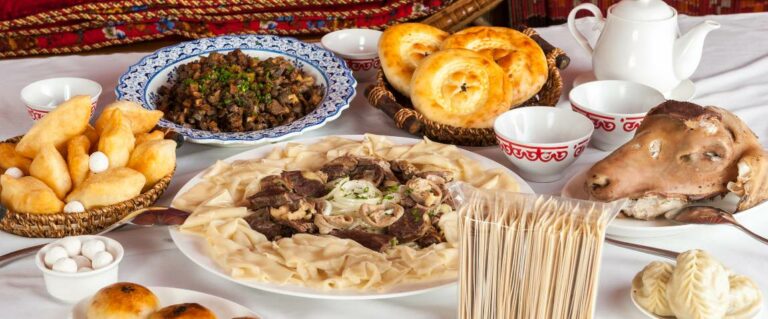Introduction: Kyrgyz cuisine and its Central Asian neighbors
Kyrgyz cuisine is a reflection of the country’s nomadic culture and the influence of its neighboring countries. Located in the heart of Central Asia, Kyrgyzstan shares its borders with Kazakhstan, Uzbekistan, Tajikistan, and China. The country’s cuisine is an amalgamation of different culinary traditions, adapted and modified to suit the taste and preferences of the Kyrgyz people.
Shared culinary traditions in Central Asia
The Central Asian region has a shared culinary heritage, with similar ingredients and cooking methods used across the countries. The use of meat, particularly lamb and beef, is prevalent in the region’s cuisine. The traditional bread, called lepeshka, is a staple across Central Asia, with variations in size, shape, and flavor. The use of spices, herbs, and vegetables is also common in Central Asian cuisine.
Cultural exchange and cuisine influences
Cultural exchange and interaction have played a significant role in shaping Kyrgyz cuisine. The country’s location at the crossroads of different trade routes has resulted in the exchange of culinary practices and ingredients. The influence of neighboring countries can be seen in the use of spices, cooking techniques, and dishes.
The influence of Uzbek cuisine on Kyrgyz food
Uzbek cuisine has had a significant impact on Kyrgyz cuisine, given the close cultural and historical ties between the two countries. The use of spices, such as cumin and coriander, and herbs, like dill and parsley, is evident in Kyrgyz cuisine, which has been borrowed from the Uzbek culinary tradition. Plov, a rice-based dish, is also popular in Kyrgyzstan, and its origin can be traced back to Uzbekistan.
The impact of Kazakh cuisine on Kyrgyz cuisine
Kazakh cuisine has also influenced Kyrgyz cuisine, given the geographical proximity and historical ties between the two countries. The use of meat, particularly horse meat, is common in both cuisines. Beshbarmak, a meat-based dish, is also popular in both countries, with slight variations in the recipe.
Chinese and Russian influences on Kyrgyz cuisine
The Kyrgyz cuisine also reflects the influence of China and Russia, the country’s northern and eastern neighbors, respectively. The use of noodles, dumplings, and soy sauce in some Kyrgyz dishes is a result of Chinese influence. Russian cuisine has influenced Kyrgyz cuisine through the introduction of dishes like pelmeni, a type of dumpling, and blinis, thin pancakes served with various toppings.
In conclusion, Kyrgyz cuisine is a reflection of the country’s cultural diversity and the influence of its neighboring countries. The culinary traditions of Central Asia, Uzbekistan, Kazakhstan, China, and Russia have all contributed to the development of Kyrgyz cuisine, resulting in a unique blend of flavors and ingredients.

